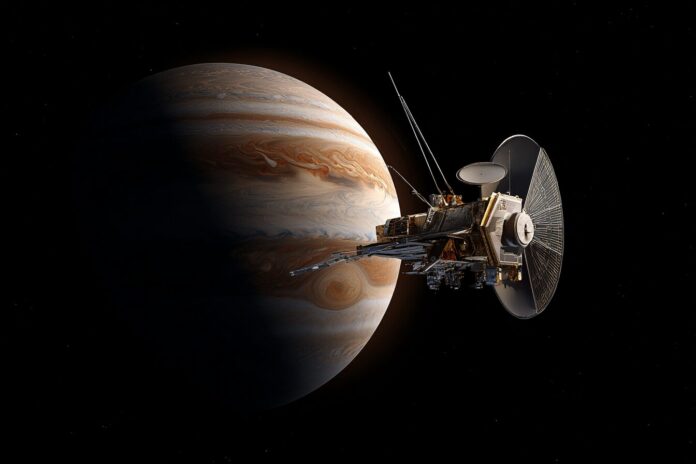New Milestones for Deep-Space Exploration
NASA’s Europa Clipper mission recently celebrated a significant breakthrough during its gravity-assist flyby of Mars on March 1, 2025. Most importantly, the mission’s advanced radar instrument, REASON (Radar for Europa Assessment and Sounding: Ocean to Near-surface), delivered flawless performance during the close encounter. This achievement marks a pivotal step toward unlocking the secrets of Jupiter’s icy moon, Europa, and demonstrates the spacecraft’s capability to gather high-resolution subsurface data in deep-space conditions.
Because the flyby allowed the team to simulate the operational challenges that lie ahead, engineers now have greater confidence in the mission’s instruments. In addition, the success of this test offers robust proof that the instrument is capable of performing under diverse planetary conditions, as reported by various credible sources, including NASA and Sky & Telescope. Therefore, this milestone not only propels the mission forward but also reinforces our expanding capabilities in deep-space exploration.
Why the Europa Clipper Flyby Matters
The flyby of Mars plays an essential role in the overall mission strategy. Initially designed to assess the habitability of Europa by examining its icy crust and subsurface ocean, the spacecraft required a series of gravity assists to gain the necessary speed and direction. Because NASA engineers carefully planned these maneuvers, the Mars flyby was more than just a speed boost; it was also a critical opportunity for instrument verification in a real-world environment. Most importantly, the REASON instrument was tested in scenarios that mirror the demanding conditions the spacecraft will face as it ventures deeper into the solar system.
Besides that, the flyby has provided invaluable scientific insights and calibration opportunities that directly benefit both ongoing Mars studies and future Europa observations. For instance, data collected during the pass helped refine data processing pipelines and instrument calibration, as detailed by NASA. Consequently, these insights facilitate smoother operations in upcoming mission phases and underscore the importance of multi-planetary engagement for testing complex space instruments.
REASON: Seeing Below the Surface
REASON, the mission’s state-of-the-art radar sensor, was primarily developed to peer below the icy exteriors of distant planetary bodies. Using radar waves, it can map hidden layers, detect subsurface discontinuities, and possibly identify liquid reservoirs beneath the surface. Because Europa’s potential subsurface ocean may harbor conditions suitable for life, understanding the ice thickness and internal structure is crucial for astrobiological studies. Most importantly, REASON’s success during the Mars flyby indicates its robust design and high sensitivity in capturing subtle radar reflections in diverse environments.
Moreover, the instrument successfully returned high-quality data as it interacted with Martian terrain, paving the way for more refined measurements when Europa is investigated. Because it can also study surface features and subsurface anomalies, REASON’s effectiveness is expected to reveal unprecedented details about Europa’s internal composition. Therefore, the breakthrough at Mars is a testament to the instrument’s precision and sets the stage for future revelations about potentially habitable environments in our solar system, as highlighted in findings published on platforms like NASA.
First Results: Detailed Data From Mars
The radar test during the Mars flyby provided a treasure trove of data, including detailed subsurface images from the Martian equator region. Most importantly, these early results confirmed that REASON can successfully bounce radar signals off planetary surfaces and retrieve echoes that reveal underlying structures. Because each radar reflection contributes to a more accurate calibration of the instrument, the successful data acquisition represents a dual victory for both operational testing and scientific research.
In addition, the detailed subsurface imagery collected offered a glimpse into the potential of capturing similar data at Europa. The opportunity to analyze natural radar echoes also allowed the science team to optimize algorithms and data processing pipelines. Therefore, the valuable information arising from this test will likely influence future mission strategies and provide a robust framework for interpreting the complex data expected from the Jovian system, as discussed in research findings available at Springer.
Preparing for Europa: The Next Frontier
Following the Mars success, NASA’s Europa Clipper is gradually preparing for the next leg of its journey. Most importantly, after a trajectory adjustment in late March 2025, the spacecraft is scheduled for another gravity assist as it returns towards Earth in December 2026. This maneuver is crucial to building the momentum necessary for the long cruise toward Jupiter, ensuring that the craft arrives with optimal speed and orientation for its detailed examination of Europa.
Because every phase of the mission is interlinked, the careful calibration of instruments like REASON during earlier flybys directly contributes to the scientific precision anticipated when Europa is reached. Consequently, the mission roadmap reflects both technical ingenuity and a deep understanding of interplanetary dynamics. These steps underscore NASA’s methodological approach to space exploration, balancing risks and opportunities while advancing our understanding of complex planetary systems, as per updates shared on NASA.
Looking Ahead: Challenges and Opportunities
Looking to the future, the Europa Clipper mission faces both remarkable opportunities and daunting challenges. Most importantly, NASA’s engineering and science teams remain vigilant as the spacecraft embarks on its multi-year journey through the solar system. Because each gravity assist and every data transmission adds to the overall knowledge base, the mission continues to evolve and adapt to unexpected conditions. Institutions and researchers are actively preparing to analyze the diverse data streams with an eye toward the mission’s ultimate scientific goals.
Therefore, as the spacecraft navigates the space between planetary bodies, every operational phase is meticulously monitored. Besides that, ongoing evaluations of instrument performance, including reinforcements from successful tests, ensure that potential technical hurdles are identified long before they could impact the mission. Most importantly, the collaboration between mission specialists and international research teams has forged a pathway toward groundbreaking discoveries in planetary science and astrobiology. Thus, the story of REASON and the Europa Clipper is one of persistent innovation and visionary exploration, promising exciting revelations about our solar system’s most mysterious worlds.



